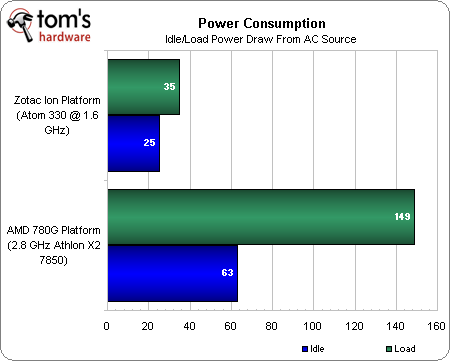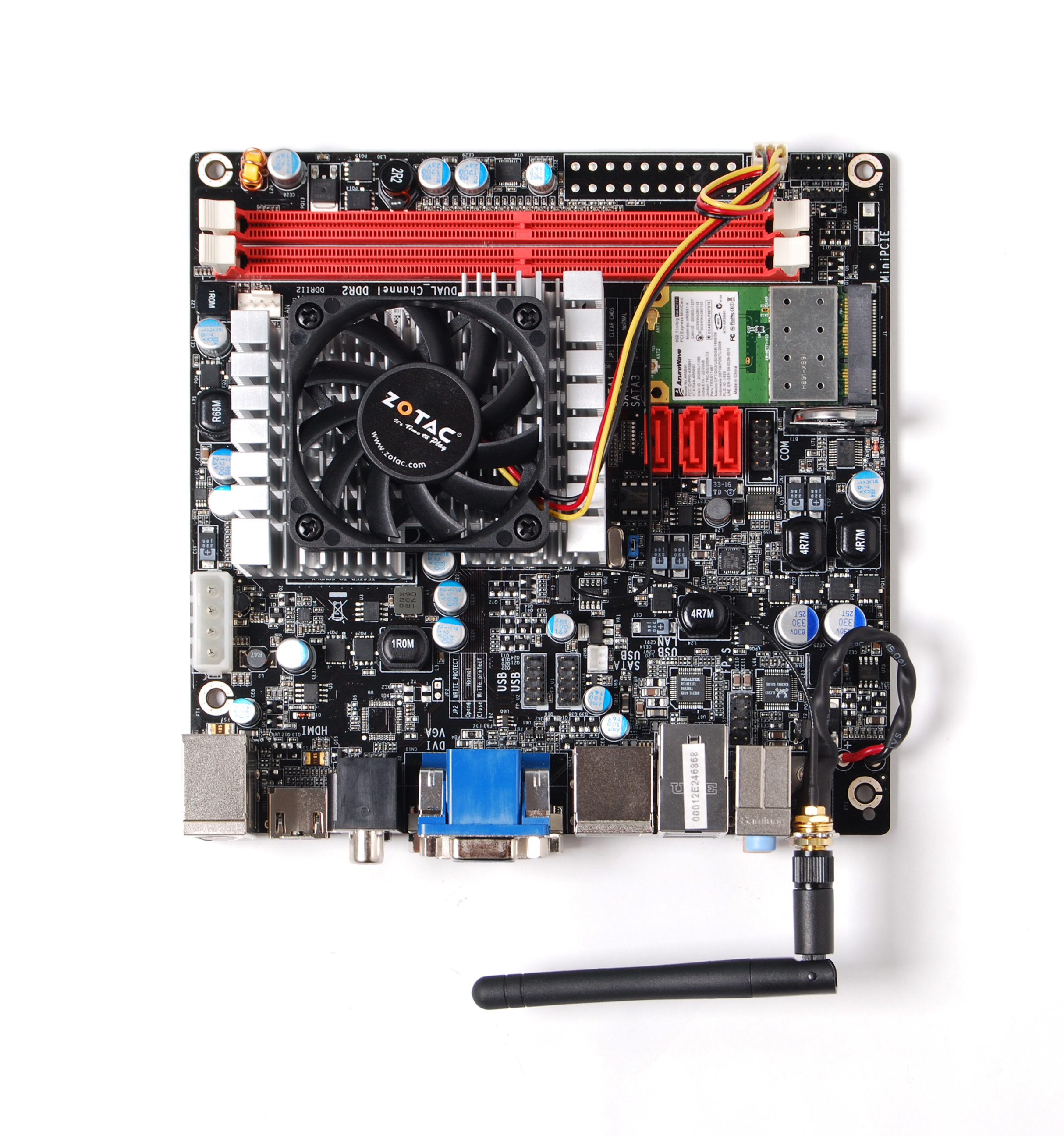Zotac's Ion Board On Windows 7: Nvidia Re-Arms Intel’s Atom
Power Consumption And Pricing
If the Ion platform is to assert itself anywhere, it’s here. The 90W power brick that Zotac ships with the motherboard suggests we’ll see particularly low numbers from the mini-ITX configuration.
Indeed, Zotac’s Ion board does incredibly well. At idle, it uses less than half of what AMD’s Athlon X2 7850 dual-core processor consumes—even with Cool’n’Quiet enabled. Under load, though, the difference is much more significant: 114 W separate the two solutions.
If low-power computing is your thing and you don’t mind the performance implications of an Atom-based PC, you won’t be able to come anywhere close to Zotac’s Ion board using desktop-class hardware.
Granted, we could have done significantly better in the power department had we been a little choosier with our CPU. The Athlon X2 7850 was attractive due to its $69 price tag, 2.8 GHz clock speed, and unlocked multiplier, but its Kuma core is still rated at 95 W. You can dip down to the $60 Athlon X2 5050e (running at 2.6 GHz) and cut your maximum TDP down to 45W for $10 less.
Pricing
As mentioned, retail pricing on the ION-ITX-A-U (the version of the board with Intel’s dual-core Atom 330) is set at $189, though it should be available for $10 less at e-tail.
Launching alongside the dual-core model are the ION-ITX-B-E with a single-core Atom N270 at 1.6 GHz, no WiFi, and no bundled power supply, the ION-ITX-C-U with the N270 plus power supply, and the ION-ITX-D-E with an Atom 330 and WiFi (and without the PSU).
Get Tom's Hardware's best news and in-depth reviews, straight to your inbox.
The micro-ATX system we built to compare against the ION-ITX-A-U is priced to go against Zotac’s e-tail target. Though online prices are going to change constantly, as of the night before publication, the MA78GM-US2H motherboard was $74 before a $10 MiR, AMD’s Athlon X2 7850 was listed at $69, and Enermax’s ETK405AST was listed at $44 (that’s $187 total, not counting the MiR).
Current page: Power Consumption And Pricing
Prev Page Benchmark Results: Gaming Next Page Conclusion-
SpadeM ReplyGranted, we could have done significantly better in the power department had we been a little choosier with our CPU. The Athlon X2 7850 was attractive due to its $69 price tag, 2.8 GHz clock speed, and unlocked multiplier, but its Kuma core is still rated at 95 W. You can dip down to the $60 Athlon X2 5050e (running at 2.8 GHz as well) and cut your maximum TDP down to 45W for $10 less.
If you knew you could have done better with a 45W not a 95W processor .. what gives? The supplier didn't have it in stock or why go for the obvious power monster?
On a different note, I'm looking forward to the transcoding article. -
one-shot Everyone down-rates the first post which is posted by the author of the article. I'm not sure if anyone has noticed that yet because I see every author's first post down-rated many times.Reply -
sublifer ReplyHere’s the short of it. When it comes to running multiple apps at the same time, compressing/decompressing large archives, and yes, even trasncoding
Just wanted to help: transcoding -
hellwig I almost wish you hadn't even tried playing games on it, but I suppose you needed some sort of comparison for the performance of the ION chipset.Reply
How many people will use this as a satellite PC in their homes, and what ever happened to Windows Home Server? I would think you let your central PC/server handle the computing and just use this guy as a remote terminal to stream media to. -
I'm looking for a low power system like this... my old father leaves his p4 system on ALL the time, and wonder why his electric bill is so high :-\Reply
-
siliconchampion I love that they mentioned the GeForce 9300-ITX WiFi board at the end of the review. I used that board with an e7400, 4GB corsair, a low profile 9800 GT, a 320GB 7200RPM 2.5 inch drive, and an Antec 380 watt PSU. The reason I love it so much is three-fold.Reply
First, I put all of the above mentioned components and put them into the case from the original Xbox (while maintaning totally stock appearances except for the back.
Second, the board boots lightning fast, and is a pleasure to work with.
Third, before we put the 9800GT into the build, using the same 9300 chipset as the Ion platform, we were running HL2 on max settings at 1680x1050 resolution (except with only 2x AA) and getting 35-45 FPS. We also played Halo 2 on medium settings and that played very well also. Obviously, after the 9800 was added, the computer flies. That just goes to show you that the Atom really is what is holding back the capabilities of the 9300 chipset.
All of this was accomplished with about $500, so it is a good budget computer that is inside of an Xbox. My i7 system has nothing on the "coolness" factor of this computer.
-
cangelini teeth_03I thought the ION platform used the Geforce 9400 and not the 9300?Reply
The difference between 9300 and 9400 is clock speed. This one is slower than the 9300, even.


